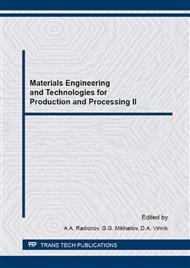[1]
A.M. Dolganov, T.N. Ivanova, Up-to-date equipment in the technology of diamond face grinding of flat surfaces: monograph, the Institute of Economics Press, Ural Branch of RAS, Yekaterinburg-Izhevsk, (2007).
Google Scholar
[2]
T.N. Ivanova, Advanced technologies of the XXI century: international joint monograph, two books, V. 1, KUPRIENKO, Odessa, (2013).
Google Scholar
[3]
F. Yu. Svitkovsky, T.N. Ivanova, Investigation of the regularities and the enhancement of the efficiency of the grinding process for components from hard-to-machine materials, Metal treatment, Technology, Equipment, Tools. 1 (2004) 22-24.
Google Scholar
[4]
T.N. Ivanova, Investigation of the surface layer structure at grinding, Metal treatment, Equipment, Tools. 3 (2005) 30-32.
Google Scholar
[5]
T.N. Ivanova, D.D. Galikhanov, Investigation of machinability of hard-to-machine steels at grinding, Natural sciences and Technics. 3 (2012) 173-176.
Google Scholar
[6]
V.B. Dementyev, T.N. Ivanova, Formation of the properties of the surface layer of components from hard-to-machine materials simultaneously at heating and cooling, Chemical physics and mesoscopy. 4 (2012) 587-598.
Google Scholar
[7]
T.N. Ivanova, V.B. Dementyev, Investigation of the physical-mechanical properties of steel 8CrV after high-speed thermal process, Chemical physics and mesoscopy. 4 (2012) 7-18.
Google Scholar
[8]
I.P. Zakharenko, Ultra-hard materials in tool production, Higher School, Kiev, (1985).
Google Scholar
[9]
D.I. Volkov, Theoretical model of the stress state of the surface layer of components at deep grinding, Herald of P.A. Solovyov Rybinsk State Aviation Technological Academy. 1 (2009) 52-63.
Google Scholar
[10]
D.I. Volkov, A.A. Koryazhkin, Finite-difference calculation of the temperature in belt grinding, Russian Engineering Research. 3 (2012) 296-298.
DOI: 10.3103/s1068798x12030240
Google Scholar
[11]
A.M. Kozlov, Model-based determination of the parameters of the working surface of an abrasive tool, Proceedings of Institutions of Higher Education: Machine-building. 1 (2005) 51-55.
Google Scholar
[12]
G.V. Barsukov, L.G. Vainer, Yu.V. Vasilenko, A.M. Kozlov, Yu.S. Stepanov, A.V. Kirichek, Modeling of technological processes of abrasive machining: Monograph, Spectr, Moscow, (2011).
Google Scholar
[13]
V.A. Nosenko, S.V. Nosenko, Technology of metal grinding: Monograph, TNT, Stary Oskol, (2013).
Google Scholar
[14]
V.A. Nosenko, A.V. Avilov, Investigation of deep grinding of steel 30CrMnCNi2 A, Proceedings of Volgograd State Technical University. 9 (2004) 29-31.
Google Scholar
[15]
V.A. Nosenko, Unidirectional and opposing deep grinding of titanium alloy with periodic wheel adjustment, Russian Engineering Research. 10 (2010) 1016-1021.
DOI: 10.3103/s1068798x10100114
Google Scholar
[16]
V.A. Nosenko, A.P. Mitrofanov, G.M. Butov, Impregnation of abrasive tools with foaming agents, Russian Engineering Research. 11 (2011) 1160-1163.
DOI: 10.3103/s1068798x11110189
Google Scholar
[17]
V.A. Nosenko, R.A. Belukhin, Interrelation between height parameters of roughness at flat infeed grinding of steel 12-Cr18-Ni10-Ti, Physics, chemistry and mechanics of tribosystems. 9 (2010) 48-53.
Google Scholar
[18]
D.V. Podzei, Technological residual stresses, Machine-building, Moscow, (1973).
Google Scholar
[19]
S.A. Popov, Diamond-abrasive treatment of metals and hard alloys, Machine-building, Moscow, (1977).
Google Scholar
[20]
F. Yu. Svitkovsky, Scientific principles of the technology of deep grinding of components from hard-to-machine materials, Institute of Technological Sciences and Industry Restructuring Problems, Izhevsk, (2003).
Google Scholar
[21]
A.N. Sulima, V.A. Shulov, Yu.D. Yagodkin, Surface layer and service properties of machine components, Machine-building, Moscow, (1988).
Google Scholar
[22]
L.V. Khudobin, M.A. Belov, Grinding of work pieces from corrosion-resistant steels with the use of lubricoolants, University Press, Saratov, (1989).
Google Scholar
[23]
G.H. Yusupov, S.A. Kolegov, T. Yu. Pusyreva, Effective diamond grinding: Monograph, TNT, Stary Oskol, (2014).
Google Scholar
[24]
P.I. Yasheritsyn, A.N. Martynov, Finishing of metals in machine-building, Higher School, Minsk, (1983).
Google Scholar
[25]
E.M. Trent, Metal cutting, Butterworth, London, (1990).
Google Scholar
[26]
T.N. Ivanova, F. Yu. Svitkovsky, T.I. Osipova, V.I. Kurko, RU Patent 2095227. (1997).
Google Scholar
[27]
V.Z. Zverovshikov, Dynamics of the centrifugal treatment of components with discrete grinding material: Monograph, Penza State University Press, Penza, (2005).
Google Scholar
[28]
D.I. Volkov, A. A Koryazhkin, More precise machining by regulating tool-blank contact in the belt grinding of gas-turbine blades, Russian Engineering Research. 9-10 (2012) 698-701.
DOI: 10.3103/s1068798x12070258
Google Scholar


